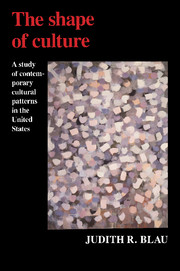Book contents
- Frontmatter
- Contents
- List of figures and tables
- Acknowledgements
- 1 Culture as structure and meaning
- 2 The American cultural landscape
- 3 Reproduction and decline
- 4 Co-occurrence, tipping in, and bridging
- 5 Organizational assembly and disassembly
- 6 Increasing returns on diminishing artists
- 7 A little more on the hobby horse
- 8 Masses and classes
- 9 The transformation of American culture
- Appendix A List of SMSAs and 1970 population in 100s
- Appendix B Sources and descriptions of cultural indicators
- Appendix C Log transformation
- Appendix D Polynomial term
- Index
- Other books in the series
2 - The American cultural landscape
Published online by Cambridge University Press: 06 July 2010
- Frontmatter
- Contents
- List of figures and tables
- Acknowledgements
- 1 Culture as structure and meaning
- 2 The American cultural landscape
- 3 Reproduction and decline
- 4 Co-occurrence, tipping in, and bridging
- 5 Organizational assembly and disassembly
- 6 Increasing returns on diminishing artists
- 7 A little more on the hobby horse
- 8 Masses and classes
- 9 The transformation of American culture
- Appendix A List of SMSAs and 1970 population in 100s
- Appendix B Sources and descriptions of cultural indicators
- Appendix C Log transformation
- Appendix D Polynomial term
- Index
- Other books in the series
Summary
I visited all of the exhibits in New York. The Medici of the Republic must exert themselves a little more before these can become even respectable … Often where a liberal spirit exists and a wish to patronize the fine arts is expressed, it is joined to a profundity of ignorance on the subjects almost inconceivable.
Mrs. Frances Trollope (1832)Probably a century after Mrs. Trollope's visit to the United States, and certainly by the middle of the twentieth century, American arts and culture had earned an unqualified recognition in international circles. Yet it is still taken as a matter of course in our times, as in those of Frances Trollope, that most forms of institutionalized high culture in the United States, such as opera, museums, orchestras, and art galleries, are highly concentrated in a very few large cities located in the east, such as New York City, Washington, Boston, and Philadelphia. It is true that midwestern cities, notably Chicago, and some older cities in the west, such as San Francisco, have fostered important high culture institutions, and more recently southern cities, such as Dallas and Houston, have intensified their efforts to establish their cultural worth. Still, the undisputed centers for the visual and performing arts are considered to be on the eastern seaboard.
The historical record supports these assumptions. Simply put, east coast cities had an early start. The concentration of wealth in Philadelphia, Boston, and New York City in the nineteenth century facilitated patronage of the arts.
- Type
- Chapter
- Information
- The Shape of CultureA Study of Contemporary Cultural Patterns in the United States, pp. 10 - 30Publisher: Cambridge University PressPrint publication year: 1989



